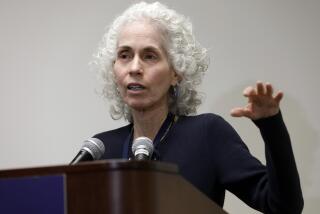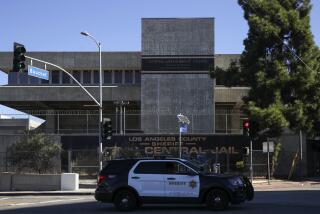Hospital Turmoil to Affect Staffing
Public hospitals and clinics across Los Angeles County could be forced to absorb hundreds of displaced doctors, nurses and other health workers as the county radically revamps Martin Luther King Jr./Drew Medical Center.
Any plan for the troubled public hospital probably would require reassigning a good portion of its more than 2,200 employees so that King/Drew can get a fresh start with a new staff, three of Los Angeles Countyâs five supervisors said last week.
There are no plans to lay off or fire employees en masse. In fact, civil service rules provide that workers cannot be terminated simply because their jobs are being eliminated or the hospital is closing or changing hands, county officials said.
It is unclear at this point what form the revamped King/Drew might take -- whether it would be handed off to another county hospital or private entity, or whether it would continue as a smaller hospital or become a community clinic. A majority on the Board of Supervisors, however, favors turning management of the hospital over to another county hospital, Harbor-UCLA Medical Center. County officials are expected to present a detailed recommendation Tuesday.
Any solution would involve âa considerable movement of personnel,â said Supervisor Zev Yaroslavsky. Supervisor Mike Antonovich said that King/Drew employees would have to reapply for their jobs, and at least some would not be rehired. Supervisor Gloria Molina said she would like âa new team of people from top to bottom.â
That means the rest of the county must absorb a flood of workers. On one hand, that would be no problem: The Department of Health Services said it has roughly 5,000 vacant positions countywide because of a shortage of health workers.
On the other hand, the reassignments may not be the most efficient use of scarce county dollars. As the health department faces a projected deficit of nearly $1.2 billion in three years, at least some reassigned King/Drew staffers would have to be closely monitored, eating up valuable staff time and creating what county officials are calling âredundancies.â
âNo question itâs going to cost us some money,â Yaroslavsky said. âMoney is not the issue.â
The issue is restructuring a failing institution in a hurry. Federal officials have decided to cut funding to the hospital, about $200 million annually, by the end of the year because it has repeatedly harmed or killed patients despite years of attempts at reform. The county hopes to retain funding through a dramatic overhaul.
Staffers have been at the heart of King/Drewâs problems. Reports and audits have repeatedly cited medical errors and poor care as cause for alarm. Moreover, a Times series in 2004 found systemic incompetence, neglect, inefficiency and lax discipline at the hospital, citing a consultantâs observation that some employees had âretired in place.â
About 650 workers have been disciplined since January 2004 for such lapses as sleeping on the job, turning down alarms on patient monitors and making fatal medical errors. Only about 250 of those were fired or resigned, according to a recent report.
Union officials are not happy with the prospects of mass transfers, particularly after so much effort has been invested in training staffers to meet federal standards.
âIn America, a basic threshold is due process, and I donât think you can wholesale take a group of people and make a single, blanket decision about their future,â said Kathy Ochoa, senior health policy analyst for Service Employees International Union 660. âI havenât ever heard of involuntary transfers in 10 years. Workers at King/Drew can be assured that they definitely have rights in any of these scenarios.â
Ochoa could not immediately detail those rights.
The head of the countyâs Human Resources Department, Michael Henry, said civil service rules give the county much greater freedom in making transfers than in implementing layoffs.
He added that he thought the county had made a âbig dent in getting rid of the bad applesâ and that many fine workers fill King/Drewâs halls and could go on to do well in other institutions.
It still is unclear whether employees of other county clinics and hospitals might transfer to King/Drew, or whether most of the staff would be hired from outside.
Peter Gruen, a neurosurgeon who runs the quality committee at Los Angeles County-USC Medical Center, said that his hospital is so understaffed that he would be happy to get King/Drew nurses.
âWe really, really need nurses for our patients,â he said. âI would hope that we take every single one of those nurses.â
Currently, more than 300 nurses and 130 physicians, not counting medical residents and temporary employees, work at King/Drew.
âIf I were there, having read all the stories about issues at King/Drew, I think Iâd be very nervous about whatâs going to happen,â said David Altman, former chief medical officer at County-USC Medical Center, who now serves in the same position at Alameda County Medical Center.
Altman said health department personnel files are notorious for failing to note problems and instead are typically filled with positive reviews, even for unreliable workers. As a result, those forced to take King/Drew workers probably will have little ability to judge the quality of the incoming staff.
âWho knows whoâs seriously a problem versus those who stumbled who were otherwise righteous people?â he asked. âThe civil service system in the county doesnât allow a way to judge someone well beyond their seniority.â
Los Angeles County civil service rules require progressive discipline, so it can take months, if not years, to accumulate enough evidence to fire an employee. Henry, of human resources, acknowledged that some troubled workers remain on King/Drewâs staff but said other health facilities would have to accept whoever is sent.
âThey donât have any say in who they get,â he said. âTo prevent the problem at the other hospitals, thatâs going to be up to the managers at the other hospitals.â
Yaroslavsky said the county has a plan to deal with unsatisfactory employees.
âNobody who is not competent is going to be put in a position where they can do damage,â Yaroslavsky said. âThe truth is that some people are borderline and will be placed in an area with greater accountability, and they will either get with the program or be fired.â
He declined to discuss the details of how such stringent oversight will be imposed.
Jean Ann Seago, director of the UC San Francisco nursing administration program, said as long as workers are divided among various institutions, an influx of King/Drew employees is unlikely to transform the culture at the receiving hospitals.
âYou would have to take an entire unit of people and transfer them to another facility to get that culture transplanted,â she said. âThe likelihood of that happening is not great.â
Yaroslavsky said the new King/Drew and other county hospitals would rise and fall depending on the overall quality of the workforce.
âThe key to making this work ... is to have competent staff,â Yaroslavsky said. âOtherwise, youâre just perpetuating the same problem under a different letterhead.â
*
Times staff writers Susannah Rosenblatt, Charles Ornstein and Tracy Weber contributed to this report.
More to Read
Sign up for Essential California
The most important California stories and recommendations in your inbox every morning.
You may occasionally receive promotional content from the Los Angeles Times.










